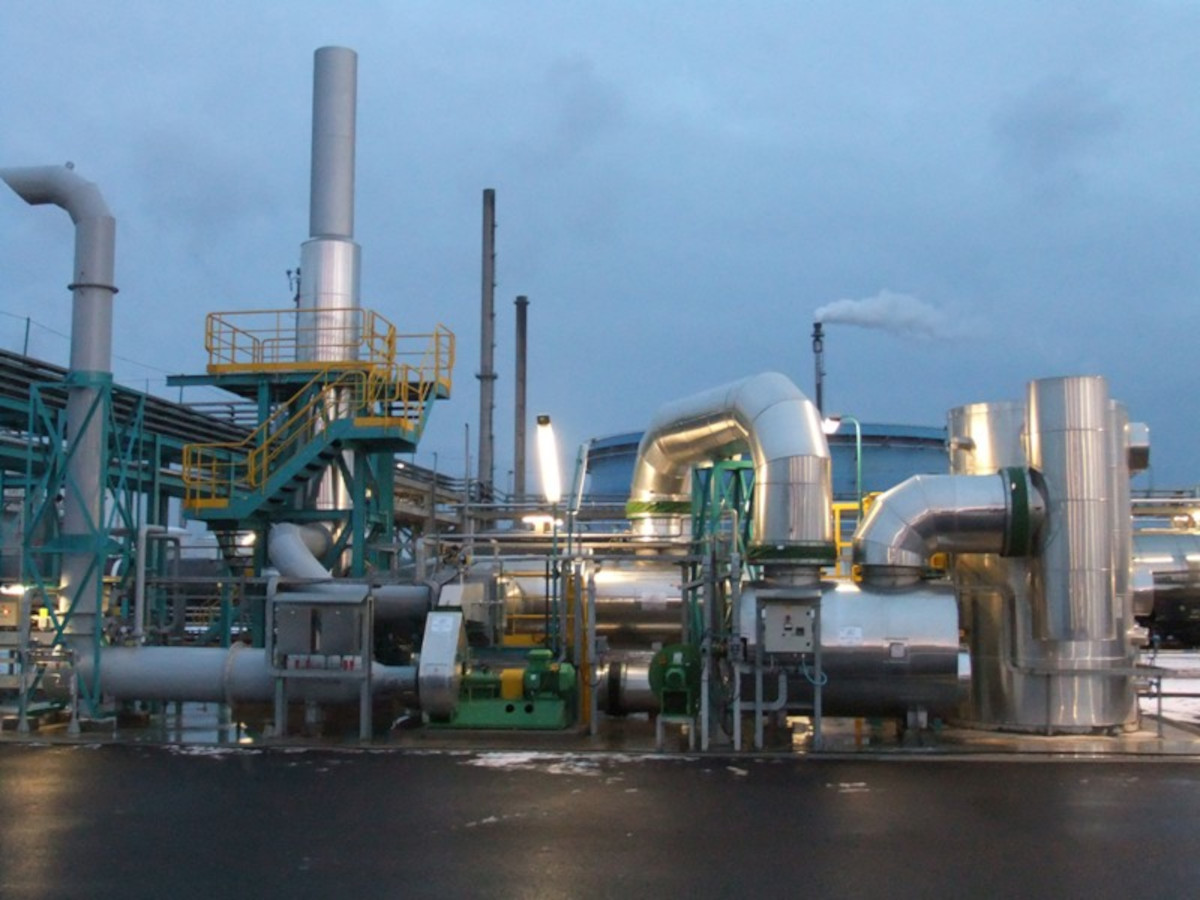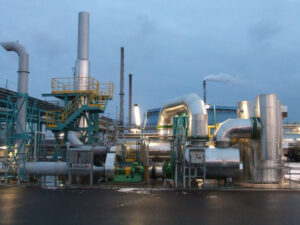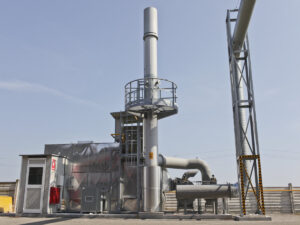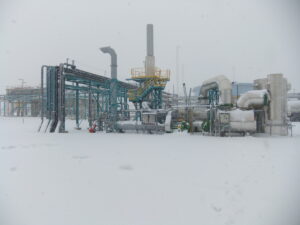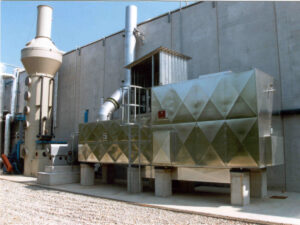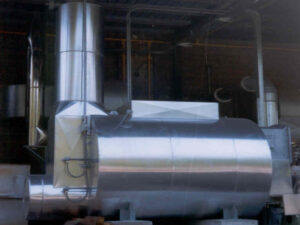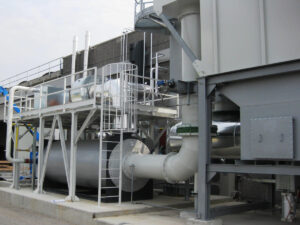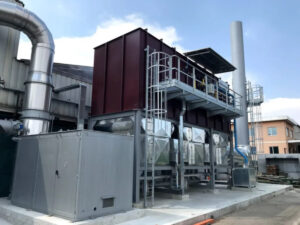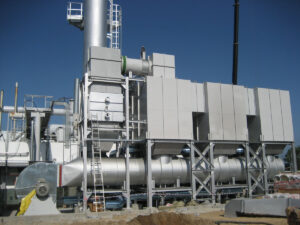- Post-combustion catalytic systems: features and advantages
- Principle of operation of catalytic afterburners
- Regenerative thermal oxidizers with pre/post treatment
- Electric thermal oxidizers – OxyTherm® eco2
- Typical applications and target sectors
- Customized plants solutions
- Go to the gallery with all our installations
Thermal catalytic oxidizers use special catalysts based on metal oxides or noble metals to promote the oxidation of pollutants, allowing conversion at significantly lower temperatures than conventional thermal incinerators. This feature allows high cleaning efficiency with reduced energy consumption.
Post-combustion catalytic systems: features and advantages
- High purification efficiency >99%.
- Totally sealed structure built using specific types of steel developed by Brofind (AISI 304, 316…).
- Reduced production of secondary pollutants (CO, NOx).
- Complete telematic management: electrical panel with PLC and remote tele-assistance.
- Independent combustion system: to ensure the correct functioning of the plant.
- Modulating combustion system: to maintain the correct operating temperature at different loads of incoming pollutant.
- Very high thermal efficiency:
- < 70% in the case of systems equipped with heat recovery.
- < 95% in the case of regenerative systems.
- Reduced maintenance.
Principle of operation of catalytic afterburners
Polluted air is aspirated by a fan and preheated by a fumes/air heat exchanger, which uses the thermal energy of the already purified effluent. The preheated flow is then sent to the combustion chamber, where an auxiliary burner maintains the necessary temperature.
Oxidation occurs when the effluent passes through the catalytic converter, which lowers the reaction temperature to a range between 280°C and 400°C, thus guaranteeing a high level of efficiency in the reduction of pollutants.
In regenerative systems, advanced heat exchange technology allows for energy recovery of up to 95%, helping to further reduce operating costs.
Catalytic thermal oxidation plants can be designed in different configurations, using:
- catalysts in the form of pellets or monoliths (honeycomb) for the removal of pollutants, for example, in combustion systems complete with heat recovery, in order to further reduce the consumption of auxiliary fuel;
- catalysts in the form of loose ceramic material (saddles) in regenerative catalytic oxidizers. There is in fact a regenerative version of the catalytic combustion system, which is ideal for low concentrations.
In the case of regenerative catalytic oxidizers, the purification process remains unchanged, but the heat recovery system is modified. With this version it is possible to push energy recovery up to 95% and achieve self-sustainability, starting from a concentration of 1.5 g/Nm³.
The type of catalyst used, both in chemical-physical terms (precious metals or common metal oxides) and in terms of geometric design (honeycomb or pellets), is chosen according to the organic substances to be broken down. With the new formulations of catalysts it is now possible to break down even chlorinated or sulphurated organic compounds. Thermal catalytic oxidation systems are very effective but the possible presence of certain pollutants in the air to be treated (such as halogenated compounds, sulfur, silicones, heavy metals) can “deactivate” the catalyst, making it necessary to replace it.
Main components of a catalytic oxidizer
- Burner: maintains the correct temperature and ensures the destruction of pollutants.
- Reactor: contains the catalyst and guarantees the residence time necessary for complete oxidation.
- Heat recovery system: allows energy savings by reusing the thermal energy of the clean effluent at the outlet to heat the incoming flow.
- Pre-treatment or post-treatment systems: to manage specific technical requirements.
Fundamental parameters for sizing
To guarantee maximum efficiency, the system is sized considering:
- Flow speed
- Polluted air flow rate
- Type of pollutant present
- Choice of suitable catalyst
- Operating temperature
BrofindⓇ equips its catalytic thermal oxidizers with advanced control systems, for simple, intuitive management without the need for complex staff training.
Regenerative thermal oxidizers with pre/post treatment
To handle complex pollutants and to ensure maximum plant efficiency, thermal oxidizers can be equipped with pre- and post-treatment systems.
✔ Pre-treatments
Pre-treatments are used to shield the oxidizer from pollutants that could jeopardize its functioning, e.g. silicon organic compounds, inorganic acids, inorganic bases, aerosol and dust. The solutions include:
- Cyclones
- Bag or cartridge filters
- Venturi and tower scrubbers
- Filtering panels
- Activated carbon adsorbers
- Filters for the removal of oily mists
✔ Post-treatments
Post-treatments are necessary when the effluent exiting the oxidizer needs further treatment to reduce specific undesired compounds, such as halogenated VOCs, sulphurates or siloxanes. Available technologies include:
- Quencher for rapid cooling
- Tower scrubbers, specifically designed for the abatement of acids and bases, ensuring pollutants neutralization before the final discharge
- Selective abatement systems to reduce specific emissions, including deNOx systems to reduce nitrogen oxides (NOx) produced during the oxidation process. DeNOx technologies include
- SCR (Selective Catalytic Reduction) with the injection of reagents such as ammonia or urea using catalytic support
- SNCR (Selective Non-Catalytic Reduction) with the injection of reagents such as ammonia or urea
Thanks to these integrations, Brofind® oxidizers ensure high performances and maximum reliability even with complex and variable flows.
Electric thermal oxidizers – OxyTherm® eco2
Brofind® offers fully electric solutions, cutting the use of fossil fuels and ensuring:
✔ Zero CO2 emissions from fuel
✔ High energy efficiency with heat recovery
✔ Compact dimensions and easy installation
✔ Reliability and reduced maintenance
Typical applications and target sectors
Catalytic thermal oxidizers are typically applied in industrial sectors that require effective abatement of VOC emissions at lower temperatures than traditional oxidizers, thanks to the use of a catalyst. The main applications include:
- Chemical industry
- Pharmaceutical sector
- Painting and coatings
- Printing and packaging
- Production of adhesives and solvents
- Electronic industry
These systems are particularly suitable for processes with low VOC concentrations and for systems that need to reduce energy consumption, guaranteeing high abatement efficiency with a lower environmental impact.
Customized plants solutions
- Development of pre-treatment sections for pollutants with silicon content (silanes, siloxanes) or streams containing dust
- Implementation of exchangers in special alloys for corrosive gases
- Secondary heat recovery with dedicated solutions for energy saving
- Use of low-emission burners to minimize environmental impact (LowNOx)
